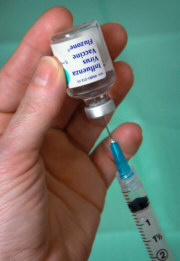May 12, 2010
Contaminated Vaccines
Although H1N1 is circulating around us at least a little bit before 1918, we passed almost 20 years free of it. In 1957, a line of influenza virus received three genes of an avian virus, among them new HA and NA, and started to be called H2N2. With these new proteins, it did not meet previous immunity in the population and completely replaced H1N1, which circulated until then. After 11 years, it acquired a new Hemagglutinin and as H3N2 it substituted the previous H2N2.
The H1N1 continued absent in the population until 1977. In this year, it reappeared in the region of Eastern Europe and North of Asia, causing a very serious pandemic, which was called Russian Flu. Ever since, both H3N2 and H1N1 circulate between us. It is thought that the H3N2 was not replaced because there was already some immunity against the H1N1 and because the population (and consequently its hosts) was already more numerous in 1977, propitiating a bigger “space” for the circulation of the virus.
However, analyses H1N1 from 1977 disclosed something disturbing. It was very similar to the H1N1 circulating in 1950, before the emergence of the H2N2. It was like the virus had reappeared, but with some aberrant facts. If it was circulating but not being reported between 1957 and 1977, it would need to be different from the known viruses, once although being a similar virus, it still would be under evolutive pressure and in differentiation. Nevertheless, it had little mutations in HA and NA genes, and the other were identical. Even worse, although it was similar to the influenza virus circulating in 1950, it was quite different of those of 1947 and 1957.
It was like the H1N1 from 1977was the 1950 virus reintroduced in the population. If so, how would it have done such a thing? Vaccines! The only way of the virus keeping its sequences so preserved is to have passed these 27 years frozen somewhere. As a matter of fact, this is the idea of the authors of the article: the virus was kept frozen in nature. Yes, to assume that it was in some freezer and was released by mistake is something that only can be done now.
However, to contaminate the vaccine with a virus by mistake is something rare, which cannot happen currently, right?
Yes and no. It is something difficult, but possible. Insomuch that it happened in the beginning of this year. In February 2009, a company which produces vaccines in Europe sent three samples contaminated to neighboring countries which were discovered because one of the laboratories tested the vaccination line in ferrets and saw that the animals died quickly. They died because the contaminating virus was the highly pathogenic H5N1.
Fortunately, samples were confined in laboratory and neither were used in vaccination nor contaminated the personnel who had contact with it. Anyway, this kind of incident raises great concerns for all involved people and demands an immediate action to eliminate the risk and disinfect all installations. Thanks to the tests done in one of the laboratories, showing again that for Influenza the prophylaxis is the best measure.
Sources:
Zimmer, S., & Burke, D. (2009). Historical Perspective — Emergence of Influenza A (H1N1) Viruses New England Journal of Medicine, 361 (3), 279-285 DOI: 10.1056/NEJMra0904322
Scholtissek, C., von Hoyningen, V., & Rott, R. (1978). Genetic relatedness between the new 1977 epidemic strains (H1N1) of influenza and human influenza strains isolated between 1947 and 1957 (H1N1) Virology, 89 (2), 613-617 DOI: 10.1016/0042-6822(78)90203-9
Kendal, A., Noble, G., Skehel, J., & Dowdle, W. (1978). Antigenic similarity of influenza A(H1N1) viruses from epidemics in 1977–1978 to “Scandinavian” strains isolated in epidemics of 1950–1951 Virology, 89 (2), 632-636 DOI: 10.1016/0042-6822(78)90207-6
3 Comments » Posted in: prevention, vaccine



[...] population (and consequently its hosts) was already more numerous … Read this article: Contaminated Vaccines « Influenza A (H1N1) Blog Posted in H3N2 Influenza Information. Tags: against-the-h1n1, already-some, and-because, [...]
[...] H1N1 circulate between us. It is thought that the H3N2 was not … Read the original here: Contaminated Vaccines « Influenza A (H1N1) Blog Posted in H3N2 Flu Information. Tags: a-very-serious, circulate-between, eastern, eastern-europe, [...]
[...] more here: Contaminated Vaccines « Influenza A (H1N1) Blog Posted in H3N2 Virus. Tags: and-because, circulation, h1n1, have-done, have-passed, [...]